
On September 8, 1996, NBC aired the very first episode of the TV series Star Trek. This is a tale that revolved around the crew of the starship USS Enterprise set to fly on a five-year mission to “boldly go where no man has gone before.”
For over a half-century, the infamous Captain James T. Kirk and Science and First Officer Spock led their fans on a long voyage exploring new worlds while looking for new civilizations and life.
Suppose there is only one thing that anyone would need to know about the televised series; it’s the abundance of fictional technologies that has even influenced scientific discoveries, inventions, and developments in our world today!
After 726 episodes, 13 movies, and four spin-offs, Star Trek proved that it could predict the future of science.
The 7 Technological Predictions of Star Trek
“Beam us up” — is probably one of the most iconic lines in television history. And more than 50 years later, Star Trek is still one of the most popular TV series ever to exist.
What’s even more fascinating is that this fictional series reimagined the power of technology way beyond what humans were capable of at the time. But, what was impossible 50 years ago is simply a matter of life today. Such technologies include:
- Communicators
- Phasers
- Telepresence
- Hyposprays
And many more!
Read on to learn more about the 7 pieces of technology Star Trek predicted during the voyage of the USS Enterprise.
1. Transparent Aluminum
Perhaps, the fourth of the Original Series Films Star Trek IV: The Voyage Home (1986) has been the most popular amongst its fans (a very subjective statement).
In this movie, the crew travels back in time to Earth of the year 1986. The exiled crew of the late USS Enterprise lands their Klingon Bird of Prey ship in San Francisco’s Golden Gate Park in their search of a humpback whale. If this sounds familiar to you, then chances are you also remember when the crew introduced transparent aluminum for the very first time.
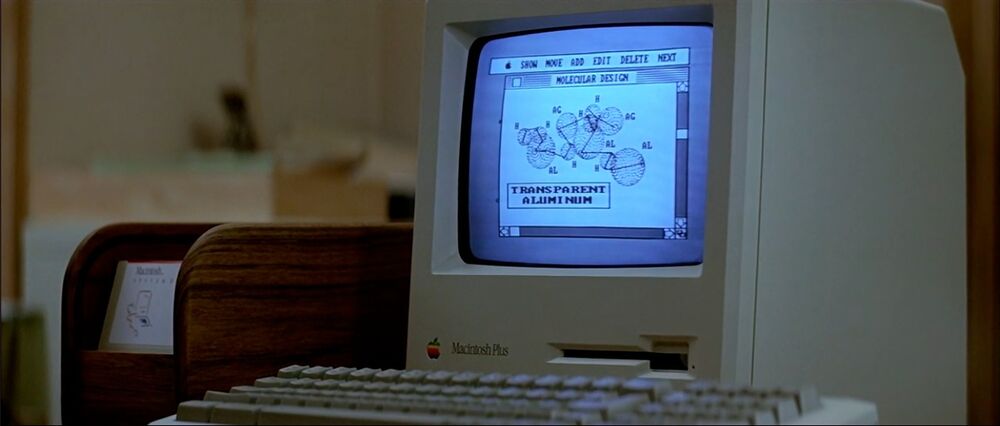
Image by Viacom CBS (was Paramount Pictures and/or CBS Broadcasting, Inc.)
To get the plexiglass sheets needed to construct a tank to transport two humpback whales, Scotty, McCoy, and Sulu had to trade the transparent aluminum formula to Dr. Nichols of the San Francisco-based Plexicorp. Accordingly, a one-inch thick sheet of transparent aluminum measuring sixty feet by ten feet, capable of withstanding the pressure of 18,000 cubic feet of water, could replace a six-inch thick plexiglass.
This technology may seem impossible to hear it the first time. However, in reality, transparent aluminum DOES exist. Which is more commonly known as ALON or aluminum oxynitride.
ALON is generally manufactured from ceramic powder. And under heat and pressure, this substance turns into a crystalline form similar to glass. When the moulded ALON is polished, it becomes even more impact-resistant.
ALON has been used as transparent armour material, which provides a bulletproof product that’s more robust and far lighter than traditional bulletproof. In 2005, the United States Air Force had also tested ALON and aimed to replace an aircraft’s canopies and windows to shield their troops.
2. Hypospray
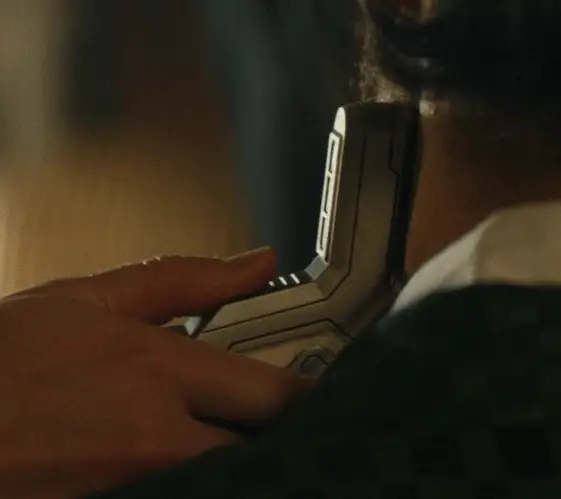
Image by Viacom CBS (was Paramount Pictures and/or CBS Broadcasting, Inc.)
Star Trek was able to find a way to spice up several activities of daily living. And one prime example is the medical treatment of vaccines.
It is a fact that not everyone can endure the injection of a needle, but Dr. Leonard “Bones” McCoy of the USS Enterprise found a new way to give people the flu shots they need.
Hypospray is a type of hypodermic injection that forces the medication under the skin using high air pressure, which do away with the need for needles. Out in the real world, this instrument is famously known as a jet injector.
The world has known of jet injectors for many years now, and they were designed originally for mass vaccinations. It is also much safer and faster in terms of administering medication.
3. Phasers (Stun)
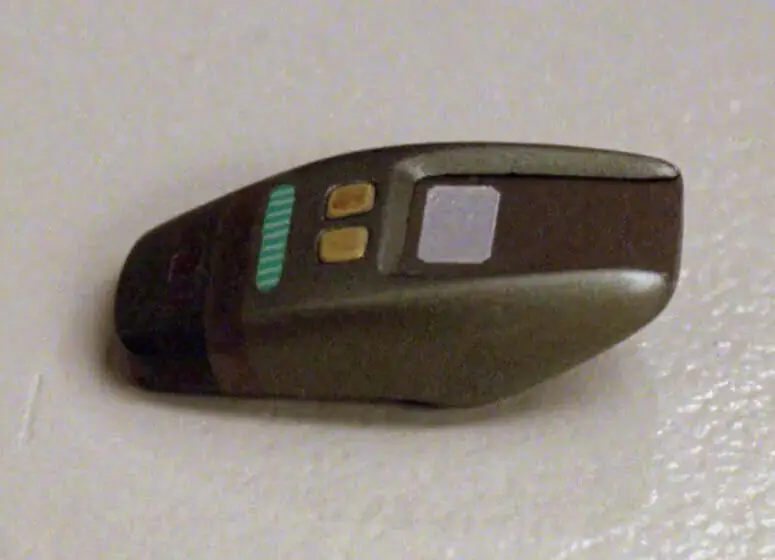
Image by Viacom CBS (was Paramount Pictures and/or CBS Broadcasting, Inc.)
“Set phasers to stun.”
Another iconic phrase part of the Star Trek Universe very similar to our modern-day police taking out a taser instead of a gun.
A phaser is a fictitious weapon equipped with a stunning feature that enables Kirk and the other crew members to not engage in lethal action but to incapacitate.
The truth is, stun guns have already existed in our society for some time. For instance, people have used electricity to control livestock ever since the 1880s. However, it was only in 1969 when Jack Cover invented the very first Taser.
Unlike a phaser, the Taser cannot cause lethal damage to its target. However, it does pack enough electrical punch to leave its victim disoriented or incapacitated.
Understandably, another difference between Tasers and Phasers is that the former needs to contact its target to work. Tasers project two electrodes with a wire connector. Once it is felt on your target, it will administer enough electric shock to produce the stun effect.
The closest technology we have to a Phaser set to stun is the Taser Gun. When the trigger is pulled, two wires with probes on each end are released and embedded on its target’s body, resulting in a 5-second burst of electricity.
4. Communicators
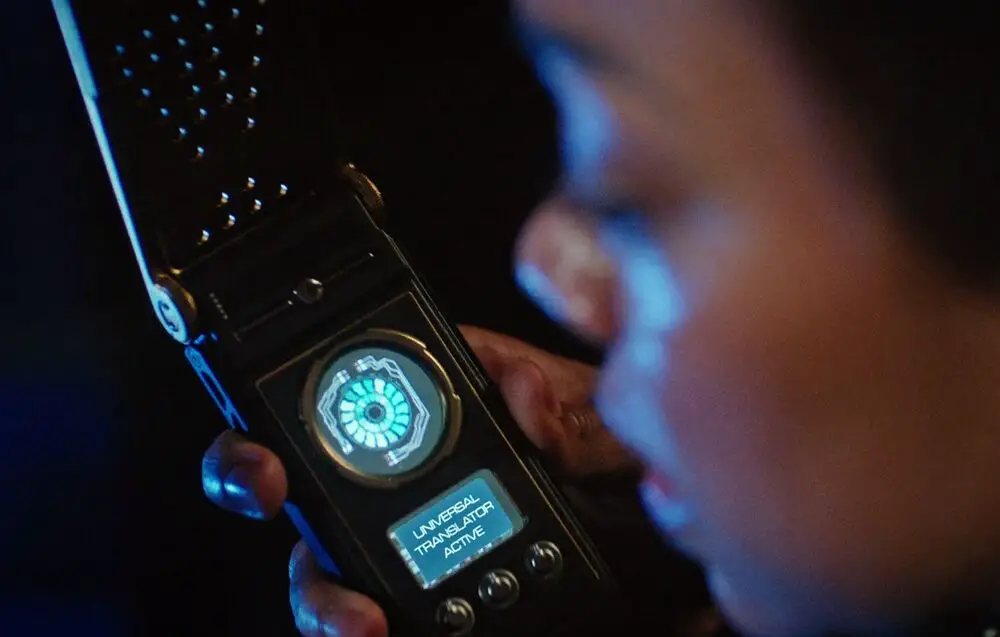
Image by Viacom CBS (was Paramount Pictures and/or CBS Broadcasting, Inc.)
Whenever Captain Kirk left the safe confines of the Enterprise, he knew that he could always contact Bones to rescue him in times of need. The only thing he needed to do was to whip out his trusty communicator and make a call.
Thirty years after the TV show had aired, it seems like everyone has a communicator with them, which has evolved into what we know as smartphones today.
The communicators used in Star Trek were much like a push-to-talk device, similar to the cell phones launched by Nextel in the mid-1990s. Additionally, both devices have a flip antenna that activates when the device is opened. But one thing is for sure, the creators of the TV series were onto something special.
In the later productions of the TV series, the communicators became more accessible by being embedded in the Starfleet logo on each crewman’s chest. With just a tap of the finger, communication between the crew became more straightforward than ever.
Despite such futuristic-sounding technology, the company Vocera Communications released a product that is quite similar to Star Trek’s chest communicator, with a device known as the B2000 communication badge.
This badge works by linking people on the same wireless LAN network within a designated area, such as a home or office. Additionally, the badge allows two-way communication and only weighs less than two ounces, meaning you can wear it on the lapel of your shirt or coat, and you won’t even feel it’s there.
Moreover, this device is very suitable for doctors or people who work in a health controlled environment as it can inhibit bacterial growth and transfer.
5. Universal Translator

Image by Viacom CBS (was Paramount Pictures and/or CBS Broadcasting, Inc.)
You can probably imagine how difficult it would be to land in a foreign country and have no means of communicating with its locals! But what if you had a tool to help understand everything they had to say? There would no need to be flustered when asking for directions or ordering food at a restaurant!
Such a convenient device, the Universal Translator, was widely used by the Enterprise crew to communicate with different civilizations they encountered in their mother tongues. They depended on this small tool to translate any alien tongues to English.
And you guessed it. This device already exists outside of Star Trek’s fictional universe! There are now tools available that allow you to translate any unfamiliar sentences or phrases you hear to a language of your choosing. However, the downside is that such a device is only applicable for a few predetermined languages.
But, why is that?
True enough, the exact universal translator from Star Trek may not be available in our current reality. However, it has already been a great technological leap to have something similar already in the palm of our hands. The technology behind voice recognition has already significantly advanced ever since its creation. But it would still take some time before computers/AI can learn a language on their own.
No doubt, computers can process information exponentially faster than the human brain. But the problem lies in the software as it requires actual data to advance its learning. This means someone needs to spend time and money to record and organize the data before the software can begin to make sense of it, which is another reason why these “Universal” Translators prioritize more popular languages.
6. Telepresence
During the 1960s, the idea of communicating with another person through the endless vacuum of space seems to be impossible, much less to control a spacecraft. But it is this exact idea from Star Trek that brought the concept of telepresence to life.
In Star Trek, Telepresence refers to a process that enables a person to control a space vessel from a safe remote location. Taking from the idea, Telepresence in our world today has been used to describe technologies that allow a person to feel as if they were present at a place other than their true location.
Telepresence is much more than simple video conferencing. In this concept, immersion is essential, and the visual aspect is vital. It is all about how realistic one can mimic the environment.
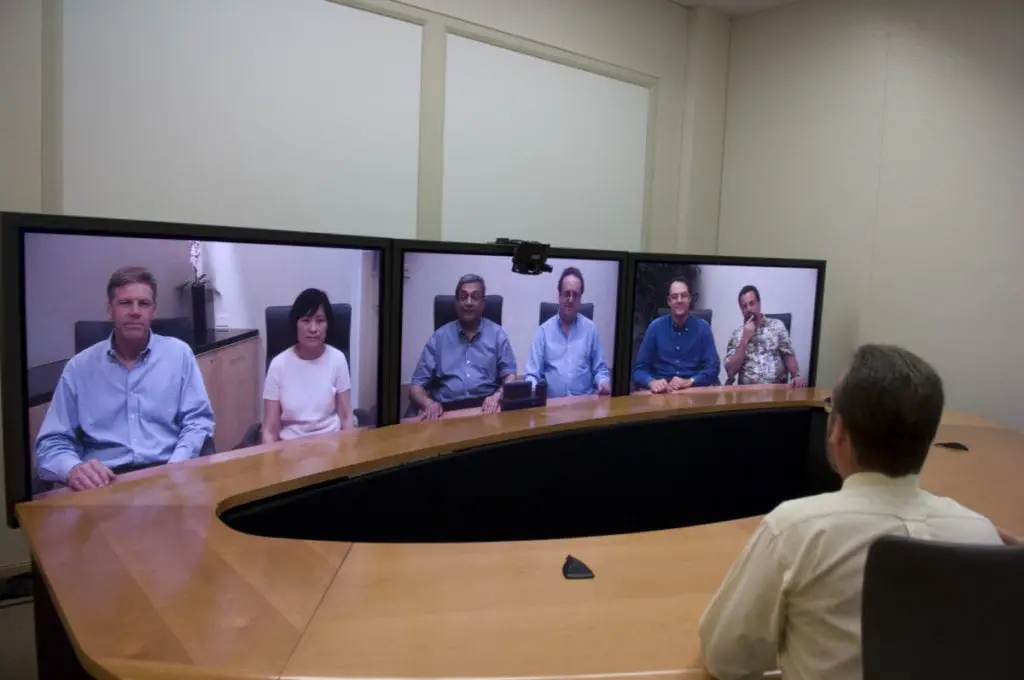
Image by Wikipedia Commons
Thirteen years ago, At&T and Cisco teamed up to deliver the world’s very first in-depth telepresence experience. With a combination of state-of-the-art video, ambient lighting, and audio blending, Cisco’s TelePresence brought a great experience to life.
The company designed these telepresence kits to mirror one’s surroundings and copy sounds on both sides of the video conference. This way, anyone who speaks will feel like they are in the same room. For instance, the person you are talking to will see you on the screen in a way that feels like you are right on the other side of the table!
7. Tricorders

Image by Viacom CBS (was Paramount Pictures and/or CBS Broadcasting, Inc.)
Do you remember the instrument that Mr. Spock used to carry over his shoulders all the time? You have probably seen it when the crew first surveys a newly discovered planet. This instrument was none other than the Tricorder, which is perhaps one of the most valuable devices that’s part of the Star Trek universe.
There are three tricorder variations:
- Engineering
- Medical
- Scientific
The Enterprise crew used this device to measure almost everything. Whether it was detecting illnesses or checking oxygen levels. If you can name it, they did it. Most of the time, the tricorder was used to perform environmental scans of a new location to provide the crew with an initial analysis within seconds’ notice.
If you are thinking about how this might tie in with the real world, then NASA has the answer for you.
LOCAD or Lab-On-a-Chip Application development is a small handheld device used to track how many unwanted microorganisms are present aboard the International Space Station. These microorganisms can include fungi, E.coli, and salmonella.
Additionally, NASA is also in the process of developing two handheld medical tools which may aid medical professionals in examining blood flow, detecting diabetes, bacterial infections, and even cancer!
Moreover, scientists at England’s Loughborough University have utilized photoplethysmography technology to monitor heart function. Harvard Medical School researchers have also developed a small tool with similar functions that can be outfitted to MRI machines.
Regardless of size, these devices developed by the world’s leading medical researchers can non-invasively inspect or monitor the human body. With nuclear magnetic resonance imaging, they gained the sensitivity needed to measure a minimum of 10 potentially infectious bacterial samples. Such is 800 times more sensitive than the sensing equipment most medical laboratories use today.
In time, this advancement can revolutionize current methods of disease diagnosis.
5 Reasons Why Star Trek is Grounded in Science
There is no denying that Star Trek is among one of the most popular sci-fi series to be ever created. Despite its length and continuity, it has successfully captured the interests of its viewers.
As a series that has gained popularity by leading its fans on voyages to places never before seen by using technologies beyond our wildest imagination, there have surprisingly been many aspects of the show to be grounded in science. If not in the 1950s, then it definitely is now.
1. Looking for life
For 30 years since the detection of the first official exoplanet in 1992, astronomers have been working tirelessly to look for other planets in our universe.
As of now, thanks to the Kepler Space Telescope, we have been able to find nearly 3,400 alien world, some of which are rocky and sit in the habitable zone of their own star! However, scientists still have no found any signs of life outside Earth.
In that respect, the USS Enterprise has us beat in their mission to “boldly go where no man has ever gone before.”
2. Artificial Gravity
In the series, the USS Enterprise utilizes artificial gravity to help their inhabitants not float around like the astronauts of the International Space Stations.
The technology we possess today enables several mechanical ways to create artificial gravity. Or, more specifically, through the use of magnetic fields. However, problems with this technology may arise.
Artificial gravity absolutely does not equate to providing astronomers with an Earth-like environment.
True enough, a strong magnetic field could do the job. But it is worth noting that it will still be weaker than the Earth’s gravity. Additionally, such strong magnetic fields could cause damages or disrupt the functioning of equipment made out of metal.
So, while generating artificial gravity is possible, experts have yet to find a safe way to implement it.
3. Computers

The computer operating system used in Star Trek: The Original Series could scan a planet to inform the crew if a planet has the right conditions to support life. And in the newer series, the operating system could create technological holodecks to play out a detective story of what has occurred on the planet.
Needless to say, the computers we own today cannot perform planetary scans, much less to predict the history of another planet. But the idea of the computer operating system for the storage and processing of information was properly grounded in the invention of the first programmable computer in the late 1930s.
4. Tractor Beams and Deflector Shields
Star Trek would not be Stark Trek if not for its breathtaking space battles.
Tractor beams and deflector shields were essential in the outcome of a fight. The tractor beam proved useful for capturing smaller vessels while deflector shields directed the impact of an attack away.
In our time, we possess the knowledge that electromagnetic fields can deflect electrically charged objects, which is a concept used to protect astronauts from cosmic radiation.
5. Cloaking device
Sometimes, a battle is not the only way. You might need to hide from your enemies to ensure you get to live and fight another day. Such is especially true if you are against one or many enemies in possession of a powerful spacecraft.
In the 2009 Reboot Star Trek: The Future Begins, the Enterprise hid in the atmosphere of Titan to avoid detection from the sensors of the Nerada. Or, if you would prefer something a little more useful, you can opt to use an artificial cloaking device possessed by the Klingon Bird of Prey.
However crude they may be, we have already been using cloaking devices in many of our vehicles today. So why do I say crude? Well, these cloaking devices service some very burdensome metamaterial layers that can only hide tiny objects in a limited colour scheme. But in the near future, experts may find new metamaterials to produce a different artificial cloaking effect.
References
1. Elizabeth Howell, 13 Things ‘Star Trek’ Gets Right (and Wrong) About Space Tech, Space, https://www.space.com/33600-star-trek-space-technology-countdown.html/ Accessed May 12, 2021.
2. Karin Lehnardt, 86 Galactic Star Trek Facts, Fact Retriever, https://www.factretriever.com/star-trek-facts/ Accessed May 12, 2021.
3. Matthew Allen, Star Trek: Science Fact or Science Fiction?, Science Made Simple, http://www.sciencemadesimple.co.uk/curriculum-blogs/space-blogs/star-trek-science-fact-or-science-fiction/ Accessed May 12, 2021.
4. Rachel Seagel, Bold Facts About Star Trek, Factinate, https://www.factinate.com/things/41-bold-facts-about-star-trek/ Accessed May 12, 2021.
5. Madie Stone, NASA Wants Kids to Use ‘Replicators’ to Design Space Food Tech, Gizmodo, https://gizmodo.com/nasa-wants-kids-to-use-replicators-to-design-space-food-1759622816/ Accessed May 12, 2021.
